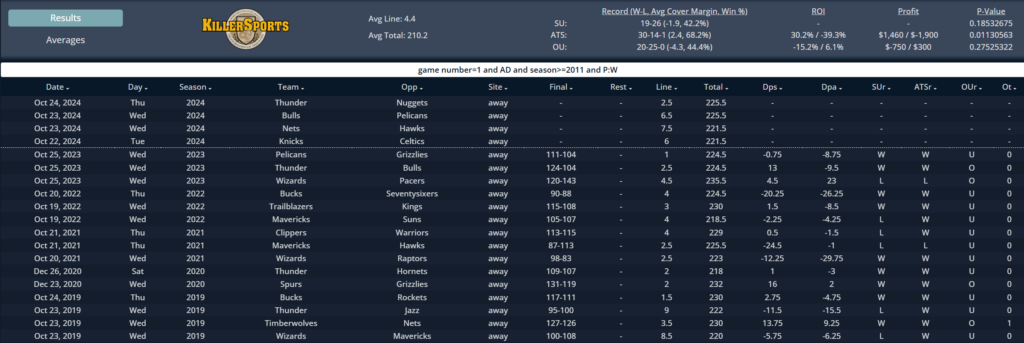Tag: nba
NBA Notes – Monday, Nov 4
Money Baller Betting Report – NBA – Sunday, November 3
Money Baller Betting Report – NBA – Saturday, November 2
Money Baller Betting Report – NBA – Friday, November 1
Money Baller Betting Report – NBA – Wednesday, October 30
Money Baller Betting Report – NBA – Sunday, October 27 (Free Preview)
Welcome Ballers! 2-3 on featured NBA trends on Saturday. See below for notes on tonight’s slate – although be wary, I am referencing trends from last season. For games not listed, we didn’t find any meaningful trends/systems worth noting.
Click here to shop our membership plans (NBA50 for 50% off your first billing cycle)
Just a reminder, here is our Money Baller Reports Schedule:
- Monday: Off
- Tuesday: Off
- Wednesday: NBA Money Baller Report
- Thursday: Off
- Friday: NBA Money Baller Report
- Saturday: NBA Money Baller Report + NFL Weekly Newsletter
- Sunday: NBA Money Baller Report
Published: Sunday, October 27, 2024, 1:30 PM CT
Milwaukee Bucks @ Brooklyn Nets
- Baller System active on the Bucks: Back a road favorite off a outright loss as a home favorite (This is not showing up as a Baller System in the matchup page, we are troubleshooting at the moment.)
- TMB thoughts: This is one of our favorite and most successful systems. We are backing the Bucks -8.5.

New Orleans Pelicans @ Portland Trailblazers
- Pelicans: 55-32-1 1H ATS (15-7 1H ATS as road favorites) last season.
- Trailblazers: 12-21 1H ATS as road underdogs last season.
- TMB thoughts: This didn’t hit last time, but is it worth another shot? Pelicans 1H -3 could be worth considering, but we are not completely convinced.
- TMB thoughts: This didn’t hit last time, but is it worth another shot? Pelicans 1H -3 could be worth considering, but we are not completely convinced.
Atlanta Hawks @ Oklahoma City Thunder
- Thunder: 25-14 ATS as home favorites last season.
- Hawks: 10-19 ATS as road underdogs last season.
- TMB thoughts: While we wouldn’t fault you for wanting to back the dominant Thunder, we’re going to pass with the Thunder on the second game of a B2B and the spread a little too high for our liking.
- TMB thoughts: While we wouldn’t fault you for wanting to back the dominant Thunder, we’re going to pass with the Thunder on the second game of a B2B and the spread a little too high for our liking.
Los Angeles Clippers @ Golden State Warriors
- Warriors: 9-1 Team Total O/U when they had more rest than their opponent last season.
- Clippers: 2nd game of B2B and outright win as an underdog.
- TMB thoughts: The Warriors’ offense has been playing more small ball (3rd in Pace, 2nd in ORTG) this season, resulting in some higher scoring games. We thought the Warriors were in a favorable spot, but rather than back the spread, we’re going to go Warriors Team Total Over 115.5.
Money Baller Betting Report – NBA – Saturday, October 26
Money Baller Betting Report – NBA – Friday, October 25
Money Baller Betting Report – NBA – Wednesday, October 23
Welcome Ballers! Nice 2-0 to start the NBA season yesterday! See below for a Game 1 system and some notes on a few of the matchups. For games not listed, we didn’t find any meaningful trends/systems worth noting.
Published: Tuesday, October 22, 2024, 11:42 PM CT
Game 1 System
Road underdogs in their first regular season game when they won their previous head-to-head matchup have gone 30-15-1 ATS since the 2011-2012 season. This is active on the Nets and Bulls for Wednesday evening.

Brooklyn Nets @ Atlanta Hawks
- Hawks: 29-54 ATS (9-18 ATS as home favorites) last season
- Road underdogs in their first regular season game when they won their previous head-to-head matchup have gone 30-15-1 ATS since the 2011-2012 season. This is active on the Nets and Bulls for Wednesday evening.
- TMB thoughts: The Hawks have proven to be one of the least reliable teams ATS, and we don’t believe they deserve to be 8-point favorites here. We’re backing the Nets +8.
Orlando Magic @ Miami Heat
- Heat’s Opponents: 11-21 1H Team Total O/U as home favorites
- Magic: 11-20 1H Team Total O/U as road underdogs
- TMB thoughts: These lines are not always readily available, but the 1H Team Total trends were interesting last season. No lines are available right now, but the Orlando 1H Team Total Under is something to keep an eye on for tomorrow.
Cleveland Cavaliers @ Toronto Raptors
- Raptors: 3-20 SU and 5-18 ATS as home underdogs.
- Raptors: went 3-21 SU to end the season last year.
- We’re high on the Cavs this season and see little reason for optimism with the Raptors. If you can get the Cavs -6.5 or better, we’re on board with that play.
- We’re high on the Cavs this season and see little reason for optimism with the Raptors. If you can get the Cavs -6.5 or better, we’re on board with that play.
Milwaukee Bucks @ Philadelphia 76ers
- Bucks: 7-20 1H ATS as road favorites.
- TMB thoughts: With Embiid out, has the line shifted too far in the Bucks’ favor? We’re passing on this one, but it’s worth noting the Bucks’ struggles in the 1H last season. Philly, playing at home, might come out with extra energy to compensate for their missing star. We’ve seen this “Injured Player Theory” prove successful int he past.
Chicago Bulls @ New Orleans Pelicans
- Pelicans: 20-11-1 1H ATS as home favorites.
- Road underdogs in their first regular season game when they won their previous head-to-head matchup have gone 30-15-1 ATS since the 2011-2012 season. This is active on the Nets and Bulls for Wednesday evening.
- TMB thoughts: With conflicting trends and both teams integrating new players, we don’t see a clear edge worth backing in this game.
- TMB thoughts: With conflicting trends and both teams integrating new players, we don’t see a clear edge worth backing in this game.
Charlotte Hornets @ Houston Rockets
- Rockets: 14-4 ATS as home favorites.
- Hornets: 14-25-1 ATS as road underdogs.
- Hornets: 11-27-2 1H Team Total O/U as road underdogs.
- Rockets: held opponents to 5-13 1H Team Total O/U as home favorites.
- TMB thoughts: The trends clearly favor the Rockets, and the market is high on them as well. We’re backing Rockets -6.5, and off the record, we’ll also be watching for a potential Hornets 1H Team Total Under.
- TMB thoughts: The trends clearly favor the Rockets, and the market is high on them as well. We’re backing Rockets -6.5, and off the record, we’ll also be watching for a potential Hornets 1H Team Total Under.
Golden State Warriors @ Portland Trail Blazers
- Warriors: 17-2 SU as road favorites.
- TMB thoughts: We don’t think there’s any action here, but thought this was an interesting trend if you were looking for a ML parlay piece.

